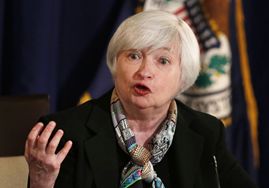Fed’s Yellen – Rate Hikes Coming Next Spring
Friday, March 21st, 2014 @ 9:56AM
Between the Lines
by Gary D. Halbert
The Fed Open Market Committee (FOMC) concluded its latest meeting yesterday and issued the usual policy statement immediately afterward. This was the first FOMC meeting with new Fed Chair Janet Yellen at the helm. She held her first press conference after the meeting. As I will discuss below, there were some policy changes made at this week’s two-day meeting.
As was widely expected, yesterday’s policy statement confirmed that the FOMC voted to reduce its QE purchases by another $10 billion to a total of $55 billion per month. The statement also confirmed that the FOMC will continue to “taper” its monthly QE purchases at subsequent meetings, suggesting that QE purchases will come to a halt before the end of this year. No surprise.
The policy statement continued to indicate that the Committee intends to keep the Fed funds rate near zero, even after QE purchases are ended this fall. No surprise there either.
The only thing new in the latest policy statement was that “…the Committee has updated its forward guidance.” The term “forward guidance” simply refers to the FOMC’s outlook for short-term interest rates going forward. The key word in the quotation just above is, “updated” – which should read “changed.” The FOMC changed its forward guidance.
That little revelation made most Fed-watchers conclude that the Yellen-led FOMC is now starting to consider when it might begin to raise short-term interest rates. This news sent stock and bond prices sharply lower during yesterday’s session, although both the 10-year and 30-year closed near unchanged on the day.
Chair Yellen handled her first post-meeting press conference quite ably, most agreed. She did have a few surprises, however. Most notably, she clarified when the FOMC is looking to start raising short-term interest rates (ie – new forward guidance). She said that the most likely time would be around six months after the end of QE. With QE on-track to end in September or October, that would mean the Fed could start to slowly raise the Fed funds rate by next spring – barring any negative surprises.
The median forecast of the members of the FOMC was that the Fed funds rate will be at 1% by the end of 2015 (previously 0.75%) and 2.25% at the end of 2016 (previously 1.75%). Compared to the last projection in December, the new numbers suggest either a slightly earlier start to rate hikes, as noted above, or a slightly more aggressive series of hikes once they start.
Yellen said not to read much into slight changes in the projected path of short-term interest rates, since that path could change one way or another at each meeting. Some speculated that this may have been her way of dismissing the contributions and importance of some of the regional Reserve Bank Presidents and Fed Governors who participate in that public forecast. In any event, it was clear that she wants the media to focus on her public statements, as well as any from incoming Fed Vice-Chair Stanley Fischer.
Yellen also said in the press conference that she wants to see faster wage growth before the Fed starts raising rates. She said she would like to see wage growth of 3-4% annually, up from about 2% now. Who knows if wage growth will have improved enough by next spring when Yellen would clearly like to start raising rates.
As expected, the FOMC dropped its earlier language indicating possible rate hikes when the unemployment rate drops to 6.5%. But rather than setting a clear new quantitative target, Yellen basically said we’d just have to trust the Fed’s judgment, and that it would use a “wide range of information” in making policy decisions, including data on the labor market, inflation, and the financial markets.
In conclusion, the more fluid and less transparent Fed approach to policy actions will likely make it harder for investors to figure out when the FOMC will start to raise rates, and it could actually inject more uncertainty into the financial markets. Yellen acknowledged that the Fed would have to straddle a fine line in deciding how much guidance to give and when to act.
What is clear is that the Fed will no longer be as “transparent” as it was under Bernanke. Maybe Janet Yellen is not so dovish after all.
As one analyst cynically put it, “If you like discretionary monetary policy – for central bankers to exercise their judgment without clear guideposts – you’ll love the Yellen Fed.”
Posted by AIA Research & Editorial Staff
Categories: Between the Lines


